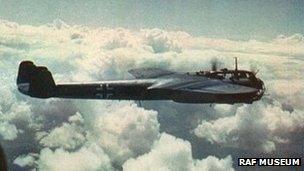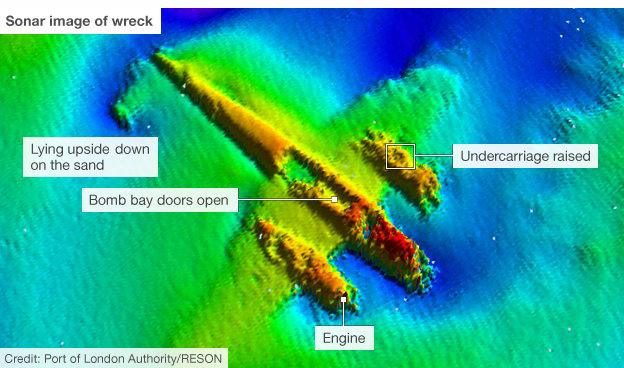German bomber salvage attempt postponed for a week
- Published
Ian Thirsk, RAF Museum: "We've come too far to give up at this stage"
An operation to raise a German World War II bomber from the bottom of the English Channel has been postponed for at least a week owing to bad weather.
An attempt on Sunday night had to be abandoned because of high winds.
The RAF Museum, which is organising the salvage of the Dornier 17 - believed to be the only intact example in the world - will discuss its options later.
Museum spokesman Ajay Srivastava said another attempt would commence when the weather improved.
But it was unlikely any attempt would be made this week, he said.
'Come too far'
Representatives of the museum and the specialist diving contractor Seatech came within minutes of lifting the wreck on Sunday night.
They are on board the salvage barge GPS Apollo and a second barge had moored alongside with a crane on board.

It is believed the Dornier 17 was shot down in August 1940 during the Battle of Britain
Divers were waiting for the current over the Goodwin Sands, off the Kent coast, to slacken sufficiently at the turn of the tide to send one man down to attach six cables to the aircraft.
But when the crane lifted the metal rig designed to spread the weight of the plane evenly, the wind caught the cables and spars hanging from the rig and they began to swing dangerously.
It was clear that to lower the rig into the water in such conditions would be too risky, not least for the diver on the seabed charged with fixing the cables with shackles to the lifting points on the plane's 70-year-old frame and on a spar inserted into the fuselage.
On Monday morning, the salvage barge returned to port in nearby Ramsgate.
The project has been dogged by unseasonal bad weather ever since the salvage barge dropped anchor 50ft (15m) above the wreck at the start of May.
So much time was lost that the original plan to build a frame or cradle around the aircraft was scrapped in favour of attaching cables directly to the plane.
The museum had allowed 35 days for the £600,000 project - I understand Tuesday 4 June is Day 35.
The RAF Museum insists this is not the end of the project and will hold a meeting ashore in Ramsgate later to discuss the options.
"We've come too far to stop now," said Ian Thirsk, the museum's head of collections.
The project has been funded partly by the museum, partly by a £345,000 grant from the National Heritage Memorial Fund and partly by the proceeds of a public appeal, which included one substantial anonymous donation.
The Dornier 17 was a mainstay of the German bomber fleets during the Battle of Britain in 1940.
The plane on the Goodwin Sands is believed to be aircraft call-sign 5K-AR, shot down on 26 August that year at the height of the battle by RAF Boulton-Paul Defiant fighters.

The Dornier 17 was a mainstay of the German bomber fleets during the Battle of Britain
- Published2 June 2013
- Published3 June 2013
- Published31 May 2013
- Published4 May 2013
- Published8 May 2013
- Published4 May 2013
- Published30 May 2013